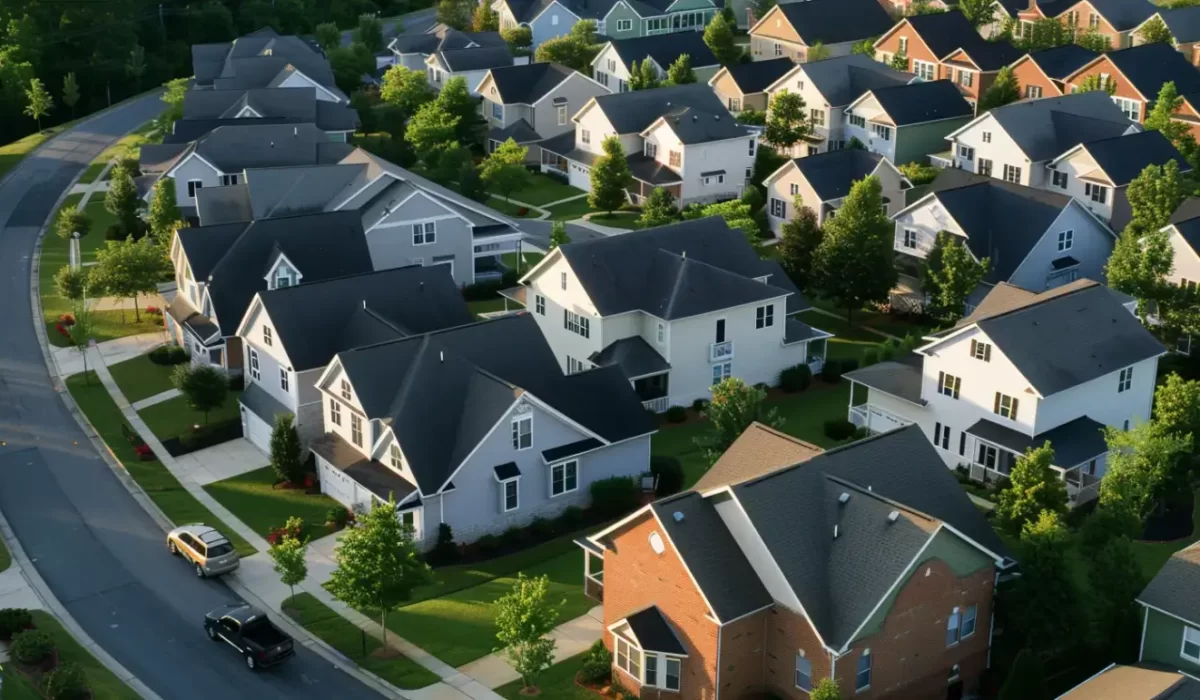Understanding different roof types is crucial for informed decisions in high-density housing. Your choice between sloped or flat roofs impacts energy efficiency, space usage, and maintenance needs. Each roofing structure offers unique benefits, especially in crowded areas where space optimization is vital. Selecting the right roof, like those offered by Fontaine Roofing in Anaheim, CA, enhances aesthetics, strengthens homes against bad weather, and improves safety and longevity.
Understanding Roof Types in High-Density Housing
In high-density housing, the choice between flat and pitched roofs impacts functionality and aesthetics. Pitched roofs drain water quickly due to their slope, while flat roofs offer usable space and facilitate HVAC installation, making them popular for industrial buildings. As a GAF Master Elite Contractor and CertainTeed Shingle Master, we ensure both types meet the highest standards. Key considerations include energy efficiency, stability, and drainage. Choosing the right roof enhances longevity and minimizes future repairs, backed by our TRI certification and memberships in CACM, CAI, and NRCA.
Contact Us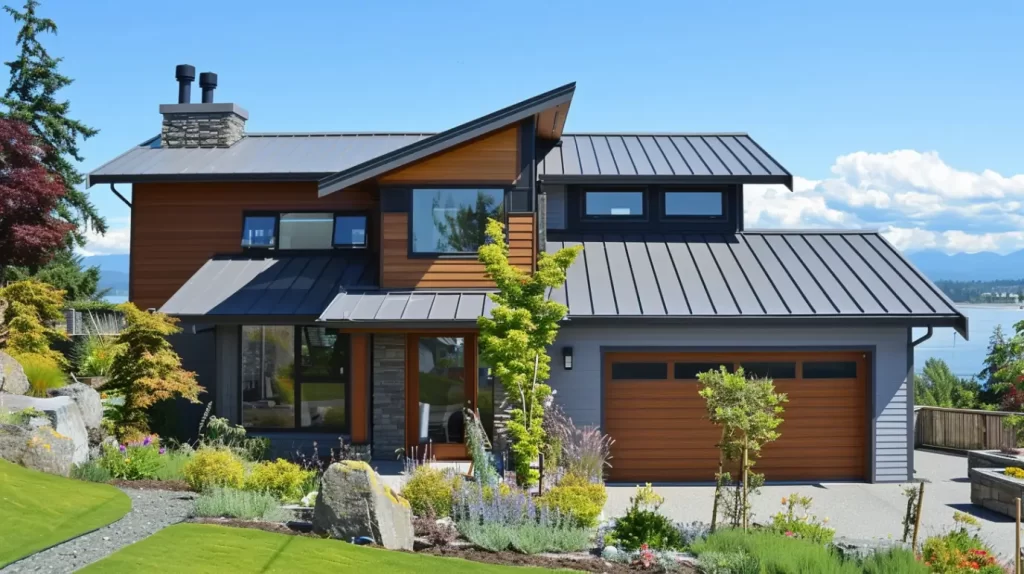
Defining Sloped Roofs: Characteristics and Applications
Sloped roofs, angled for efficient water runoff, are ideal for heavy rain or snow. The slope prevents water buildup, reducing structural damage risks. Common materials like asphalt shingles and metal roofs offer durability and aesthetic appeal for modern homes. Sloped roofs enhance insulation and energy efficiency, increasing property value with their attractive design.
Defining Flat Roofs: Characteristics and Applications
Flat roofs have a slight slope and are ideal for urban homes and businesses. Commonly made of asphalt or rubber, they provide additional usable space, often serving as rooftop gardens or relaxation areas. Factories and warehouses favor these roofs for their easy installation and cost-effectiveness within the flat roof system. However, a proper drainage system is essential to prevent water damage and extend the roof’s lifespan, especially in regions with heavy rain or extreme weather.
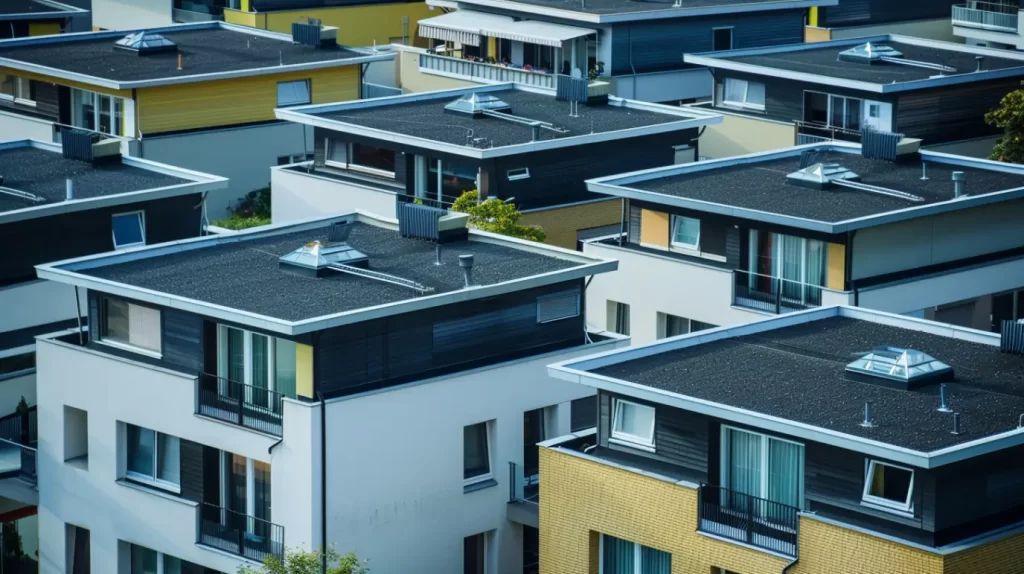
Key Differences Between Sloped and Flat Roofs
Sloped and flat roofs differ in construction and function. Sloped roofs, including a steep sloped roof design, efficiently channel water away, minimizing water damage risks and protecting the building. They can be made with various materials like asphalt shingles and metal, enhancing durability.
Flat roofs are easier to construct and allow for rooftop spaces, such as gardens. However, they require proper drainage to prevent water damage. Understanding these differences helps people make informed choices for densely populated areas.
Structural Design and Load Distribution
Understanding the construction of sloped and flat roofs, including the roof slope, is essential for weight distribution. Sloped roofs typically have a pitched design that facilitates water runoff, crucial during heavy rain, as it spreads weight across structural members for strength.
Conversely, flat roofs require effective drainage systems to prevent water accumulation, which can lead to structural damage. The choice of roof impacts the stability of the roof and longevity of a tall building, influencing its drainage system and ability to manage heavy rainfall.
Common Building Materials Used
Various materials are used for sloped and flat roofing, each offering distinct benefits. Sloped roofs typically feature asphalt shingles, metal roofing, or tiles, promoting quick water runoff while enhancing aesthetics. Roof sheathing is also an essential component in sloped roofs, providing a stable base for these materials. In contrast, flat roofs generally utilize EPDM, TPO, or spray foam, excelling in waterproofing and insulation.
Your choice of roofing material influences the roof’s longevity and energy efficiency. It also affects maintenance needs over time and the roof’s ability to withstand various weather conditions.
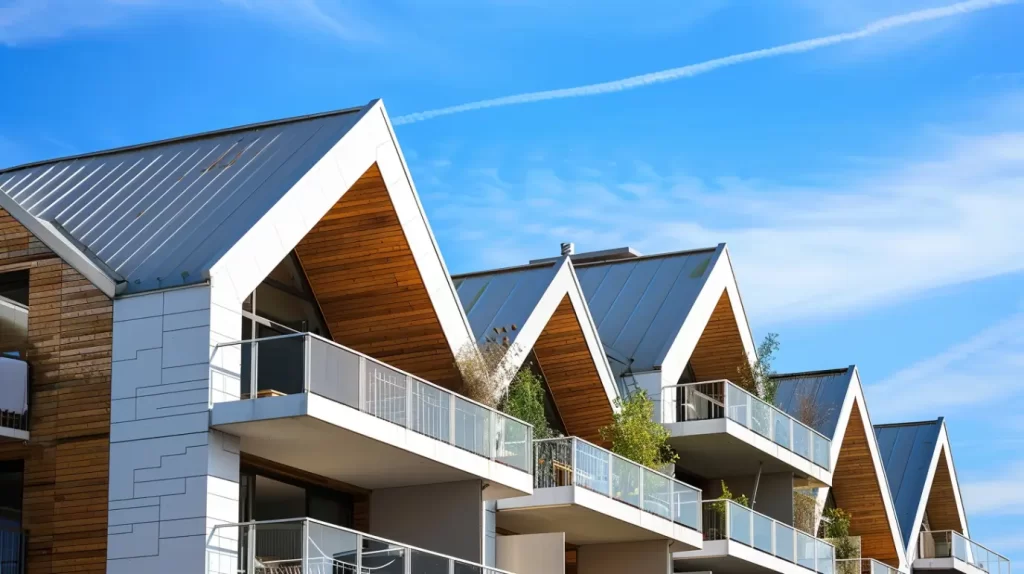
Pros and Cons of Sloped Roofs for Multi-Unit Residences
Sloped roofs are ideal for multi-unit homes, facilitating water runoff and reducing the risk of damage during heavy rains. They also enhance durability against harsh weather.
However, installing a pitched roof can be costly, and the usable space underneath may be limited. Professional installation may also be necessary. Weighing these factors will help you make an informed decision about your roofing options.
Advantages: Water Drainage and Weather Resistance
Sloped roofs efficiently drain water, making them ideal for areas with heavy rain. Their design prevents pooling, protecting the roof and home from structural damage over time. These roofing systems also withstand harsh weather, including snow and wind, ensuring durability. Materials like metal or asphalt shingles maintain their integrity throughout the roof’s service life, even in extreme conditions.
Disadvantages: Cost and Usable Space Limitations
Sloped roofing systems usually need a high upfront investment. This is because the structure is often complex and the materials can be costly, like asphalt shingles or metal roofing. In urban areas, these roofs may look good, but they can take away usable space. This is important when you want to use rooftops for things like green spaces. The steep shape also makes it hard to add items or build on the roof. This limits what you can do with the building and affects how well the space works for people.
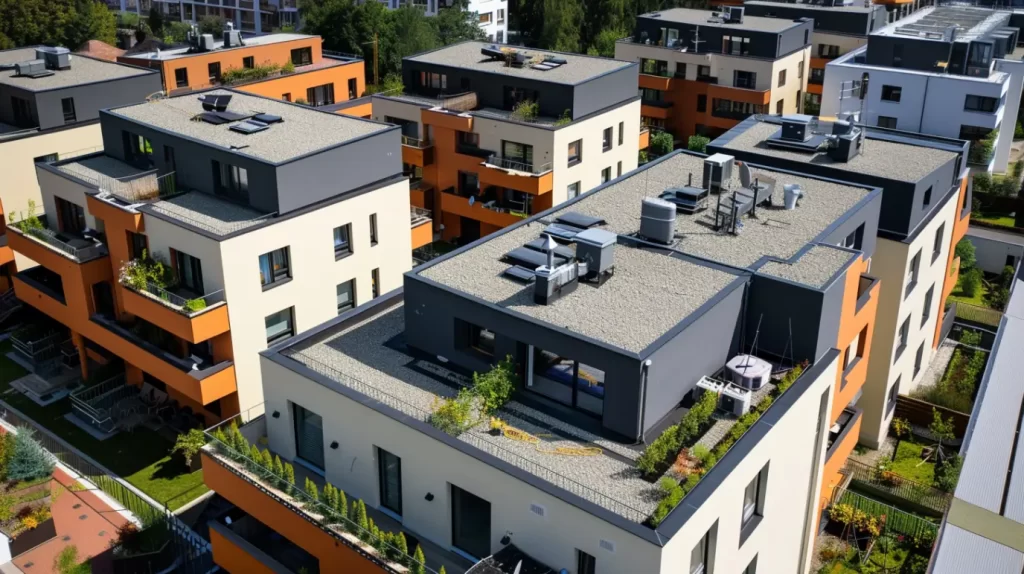
Pros and Cons of Flat Roofs
Flat roofing systems are beneficial for buildings with many residents, providing usable space like rooftop gardens and relaxation areas. However, they can present drainage issues that may lead to water damage or stability problems. Proper drainage systems and regular maintenance are essential for longevity. By considering these factors, developers can choose the best solutions for their projects and residents’ needs.
Advantages: Usable Rooftop Space and Flexibility
Usable rooftop storage space allows homeowners to utilize their flat roofs creatively. You can transform this area into a roof garden for relaxation or urban gardening. Additionally, its structure can support solar panels, enhancing energy efficiency and reducing bills.
The accessibility of flat roofing systems simplifies maintenance, prolonging the lifespan of your upgrades. Overall, these enhancements can increase your property’s value.
Disadvantages: Drainage Challenges and Leak Risk
Flat roofing systems often struggle with water drainage, particularly during heavy rain or extreme weather. Poor drainage systems can lead to standing water, risking water damage and structural issues. Leaks may also occur due to thermal expansion and contraction, damaging the roof surface. Regular maintenance is essential for identifying weaknesses early, ensuring the roof’s longevity and effectiveness, especially in densely populated areas.
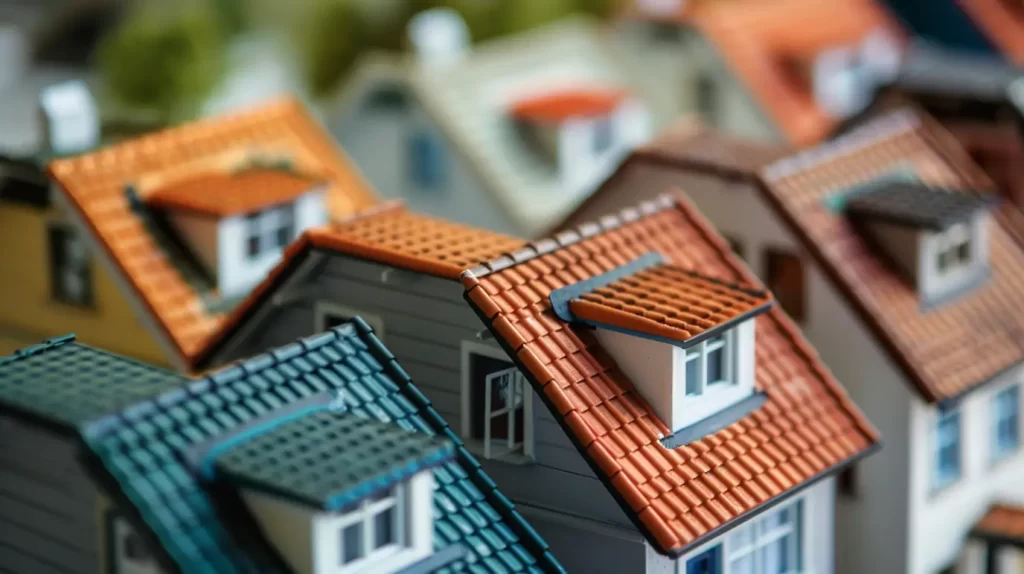
Energy Efficiency and Insulation Considerations
The energy efficiency of roofing systems, including roof insulation, matters a lot for residential buildings. This is even more true in places with many homes close together. Sloped roofs often have good insulation, like spray foam. This helps cut down on heat loss when it is cold. These types of roofs also help drain water well during heavy rain.
Flat roofs can be used for green roofs or gardens. These options help with insulation and can lower heat in busy cities. It is important to choose the right materials and take care of the roof. Good care helps keep the roof working well for a long time, even in tough weather conditions. All of this helps high-density residential buildings stay strong and energy efficient.
Thermal Performance of Sloped Roofs
Sloped roofs enhance energy efficiency in homes, especially in extreme weather. They facilitate water drainage, reducing the risk of structural damage. Additionally, sloped roofing systems allow for easier insulation installation, such as spray foam, which retains heat in winter and minimizes heat loss in summer. This improves roof longevity and lowers energy bills for multi-unit residents. Proper roofing choices and slope play a crucial role in tough weather conditions.
Thermal Performance of Flat Roofs
Flat roofing systems manage heat differently, particularly in urban areas with high temperatures. Their low slope exposes more surface area to the sun, increasing warmth. Effective insulation is crucial for energy efficiency, preventing heat loss and excessive roof temperatures. Materials like spray foam and reflective coatings help maintain cooler roofing systems and minimize thermal expansion. Regular maintenance is essential to avoid drainage issues, ensuring roof stability during extreme weather. By using appropriate materials and maintaining the roof, you enhance its longevity and performance year-round.
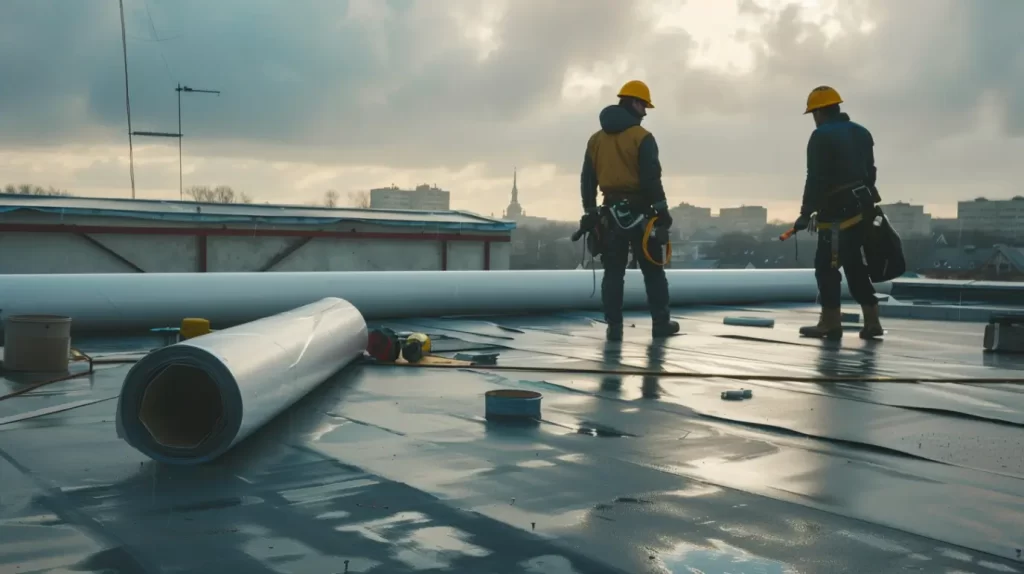
Maintaining Flat and Sloped Roofs
Regular maintenance is crucial for both sloped and flat roofing systems to ensure their longevity and functionality. For sloped roofing systems, periodic inspections of the roof surface, including checking for wear in materials like asphalt shingles or metal roofing, help prevent water damage. Flat roofing systems require diligent attention to drainage systems and sealing to avert leaks and drainage issues. Addressing minor repairs promptly can significantly enhance the structural integrity and energy efficiency of the roof, safeguarding against severe weather conditions and extending its service life.
Key Differences in Maintenance Needs
Maintenance needs vary for sloped and flat roofs due to their structural differences. Sloped roofing systems promote water drainage, minimizing the risk of standing water and damage. In contrast, flat roofs require a strong drainage system to handle accumulated precipitation, which can cause leaks. Regular maintenance is essential for both types, but flat roofs may need more frequent inspections to prevent water damage and maintain stability. In Anaheim, CA, Fontaine Roofing specializes in maintaining both sloped and flat roofing systems to keep your home safe and secure.
Connect With Us
When choosing between sloped and flat roofing systems for high-density housing, consider various factors such as construction, energy efficiency, and weather conditions. Each roof type has its advantages and challenges, especially in fluctuating climates that affect durability and maintenance. To make an informed decision, evaluate your building’s needs, including drainage, usable space, and overall performance to ensure long-lasting benefits for all. Our Polyglass Preferred Contractor status and FiberTite approval reflect our commitment to quality. Companies like Fontaine Roofing in Anaheim, CA, can provide valuable insights and expertise to help you choose the best roofing option for your project.
Read our blog: How to Present Roof Plans to HOA Boards Effectively
Frequently Asked Questions
Which roof type is more cost-effective for high-density housing over time?
When you look at cost over time, sloped roofs can be more expensive at first. But they last longer and need less maintenance. On the other hand, flat roofs have a lower installation cost to put in at the start. Still, over the years, you might have to pay more because of drainage issues and other repairs that can come up.
How do local climate and weather conditions affect the choice between sloped and flat roofs?
Local weather plays a big role in picking the right kind of roof, especially during extreme weather conditions. If there is a lot of rain or snow in an area, most people go with sloped roofs. This is because sloped roofs help water and snow flow off easily. On the other hand, flat roofs work better in places that do not get much rain. In dry climates, you do not have to worry much about water building up on the roof.

